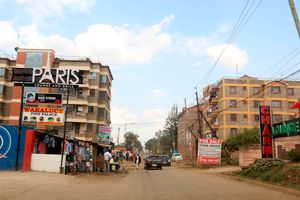Alarm as carbon monoxide levels rise in Nairobi

A recent study, called Tupumue, a Kiswahili word meaning ‘let us breathe’ shows that despite most of the urban homes in Nairobi using Liquefied Petroleum Gas (LPG) which is considered ‘cleaner’, the carbon monoxide concentration is comparable to wood and charcoal that is mostly used in rural areas.
What you need to know:
- Scientists from Kenya, in collaboration with those from the Stockholm Environment Institute, the United Kingdom’s London School of Hygiene and Tropical Medicine and from the University of Sterling conducted a study in about 179 households in Buruburu (a middle-class estate in Nairobi city) and Mukuru (an informal settlement in Nairobi) to ascertain levels of CO.
- The study, called Tupumue, a Kiswahili word meaning ‘let us breathe’ shows that despite most of the urban homes using Liquefied Petroleum Gas (LPG) which is considered ‘cleaner’, the carbon monoxide concentration is comparable to wood and charcoal that is mostly used in rural areas.
Mary Achieng fans her charcoal jiko in preparation for a lunchtime meal just outside her one-room tin house in Maranatha village, Kibra, a slum in Nairobi City.
The more she fans the flames, the more the firelighters under the jiko produce black fumes as they come into contact with the charcoal. As her two-week-old baby sleeps in the house, the fumes sneak inside, and the only ventilation is the partially open door.
For her, it is just a usual routine for meal preparation, but to scientists, the fumes represent a lurking danger for her family, especially the baby.
While most studies show that rural areas are likely culprits for indoor air pollution gases such as carbon monoxide (CO), a new study conducted in Nairobi by Kenyan scientists shows that urban centres have equally high concentration levels.
Ms Achieng started using the charcoal jiko three years ago after ditching a clean cooking fuel because she could not sustain the cost. She previously used ethanol as a cleaner option for cooking.
“Ever since I started using the jiko, I have been experiencing frequent headaches. I usually feel my veins beating so fast but I never go to hospital.... I prefer getting over-the-counter drugs because they are cheaper and readily available,” she tells the Nation.
Ms Achieng’s house is a bit musty, and friends advised her to use the jiko to keep her baby warm. The slow, painful aches that she gets are not the only negative impacts that she has had from using a jiko.
“I sometimes cough, and there is blood in my sputum. I don’t like going to hospital because explaining myself to a doctor is hard, so I prefer to go to a chemist. When I saw blood in my sputum, however, I went to hospital because that was alarming,” says Mary.
Ms Achieng cannot use the jiko outside her house because her neighbours complain of the smoke.
“I fear that my child too will be affected by the jiko, I don’t know when and how…but I know it is certain. I wish I could afford an alternative,” she says.
A few metres from where she stays is Maurene Awino, who lives with her sister in a semi-permanent house. She cooks on a kerosene stove.
“I grew up in the village, and I have always used firewood as fuel. In the village, I could get eye-aches only but when I started using the stove in the city, I developed frequent headaches and a swelling on my neck. I went to hospital and I was told the swelling is linked to the stove fumes, I just don’t know how,” she says.
Scientists from Kenya, in collaboration with those from the Stockholm Environment Institute, the United Kingdom’s London School of Hygiene and Tropical Medicine and from the University of Sterling conducted a study in about 179 households in Buruburu (a middle-class estate in Nairobi city) and Mukuru (an informal settlement in Nairobi) to ascertain levels of CO.
The study, called Tupumue, a Kiswahili word meaning ‘let us breathe’ shows that despite most of the urban homes using Liquefied Petroleum Gas (LPG) which is considered ‘cleaner’, the carbon monoxide concentration is comparable to wood and charcoal that is mostly used in rural areas.
“This aligns with previous findings that suggest that ‘cleaner’ fuels do not always generate the desired levels of reduction in household air pollution. A substantial proportion of homes (nearly one in 10) had measured concentrations that would activate a European carbon monoxide alarm, suggesting that there is likely to be a considerable unquantified burden on health from acute CO exposure and CO poisoning,” the study explains.
The Toxicological Profile for Carbon Monoxide report published by the National Library of Medicine explains that CO is produced when carbon is incompletely burnt in liquid, solid or gaseous fuels. It is classified as a major air pollutant.
Using a low-cost CO logging device, the scientists measured CO levels in the sample households every minute for more than 24 hours.
They measured every unit of CO per million parts, shortened as ppm. Overall, the mean of all the households in the study was 4.9ppm.
Half of the homes had detectable CO concentration for at least 847 minutes during the 24-hour period.
“24-hour mean CO concentrations were broadly similar in homes in Mukuru (5.1 ppm) and Buruburu (4.7 ppm),” shows the study.
“If we assume that our sample of homes taken from two specific areas is broadly representative of homes across Nairobi (population 5.3 million), then this conservative 9.4 per cent figure would suggest that about 500,000 people in the city live in homes where CO concentrations are high enough to activate a CO alarm and therefore pose an acute health risk,” explains the scientists.
The study explains that prolonged exposure to CO, especially in the evening or overnight, can be detrimental since exposure after five to six hours results in a high CO burden in the tissues. This then affects the normal functioning of the oxygen-circulating protein found in the red blood cell (haemoglobin), leading to a high concentration of carboxyhaemoglobin (a combination of carbon monoxide and haemoglobin).
Dr Evans Amukoye, a senior principal clinical research scientist from the Kenya Medical Research Institute who participated in the study, says that burning charcoal produces high levels of carbon monoxide, but kerosene stoves also produce gas.
“It has been shown that an increase of just one part per million increases mortality by almost 1 per cent on a daily basis. So some of the deaths occurring in the country, in Nairobi, could be because of this CO poisoning, even though some of those studies will not rule out CO plus the particulate matter,” he explains.
The World Health Organisation describes two types of particulate matter, abbreviated as PM, as dangerous: PM 2.5 and PM10.
Particulate matter 2.5 means that an air pollutant has a diameter equal to, or less than 2.5.
In households like Ms Acheing’s, where there are children, he explains that by the time they wake up, they are likely to have a feeling of nausea and a headache. School-going children may not concentrate in class, leading to low performance. For pregnant mothers, it affects both the mother and the unborn child.
“This is why we get some children from such households born premature and growing up, they may have neurodevelopmental challenges,” he explains.
Dr Amukoye suggests that a solution that can help is embracing clean cooking, which some families, especially those in informal settlements, find expensive.
The country’s Ministry of Energy and Petroleum has a strategy dubbed the Kenya National Cooking Transition Strategy which runs from this year to 2028.
The strategy indicates that about 9.1 million households in Kenya still rely on traditional cooking fuels, with wood accounting for the largest percentage.
However, their report shows that urban households use more charcoal as a primary source of fuel than rural households.
Nakuru, Kakamega, Nairobi, Bungoma and Meru counties have the highest deficit of clean cooking solutions. Overall, the ministry’s data shows Kenya’s uptake of clean cooking fuels has doubled from 15 per cent to 31 per cent in recent years.
This is even as a recent Clean Cooking Africa summit, organised by the International Energy Agency (IEA) and hosted in Paris, France, caused jitters from civil societies because of the approach it took in addressing the big issue.
About 2.3 billion people—close to a third of the global population—lack access to clean cooking options and often rely on dirty fuels like charcoal or wood. The IEA says this has a ripple effect, leading to about 3.7 million premature deaths.
Mohammed Adow, founder and director of Power Shift Africa, said in a press statement that the organisers were not in touch with African reality regarding the use of dirty fuels for cooking.
“There’s no mention of the absolute poverty and empowerment of the women who are currently forced to use dirty fuels for cooking. There is also no mention of developing a local economy in clean cooking technology that would be sustainable over the long term,” he said.
“What we need is a woman-centered approach that puts their needs first, not those of a greedy private sector looking to make profits. There is a growing argument that most women who could afford and access gas for cooking could also afford and access electric cooking, which can be powered by renewable energy. That should be the focus,” he advised.
The summit ended with a $2.2 billion pledge to accelerate clean cooking in the continent.
The IEA advises that main options for clean cooking are improved biomass stoves, e-cooking or electric stoves, bio-digesters, ethanol, gas stoves and LPG stoves.





